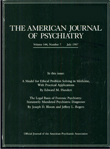Seasonal Variation in the Occurrence of Homicide in Finland
Abstract
OBJECTIVE: Although seasonal variation in impulsive aggression related to circannual rhythms of central serotonin neurotransmission is a topic of current interest, there is little firm knowledge on seasonality in the occurrence of homicide. Longitudinal studies on the seasonal rhythms of platelet imipramine binding and l-tryptophan levels have placed the circannual peaks around January and February and the nadirs around May and August. The aim of this study was to test the hypothesis that the number of homicides is the lowest during winter and the highest during spring and summer. A secondary hypothesis was that the seasonal variations in homicides and violent suicides are correlated. METHOD: The largest database on the monthly occurrence of homicide thus far (N=4,553) was used in this study, in which the monthly occurrence of all murders and manslaughters in Finland during the years 1957–1995 was analyzed. RESULTS: During winter the homicide rate was 6% below the expected rate. Correspondingly, during summer there was a 6% elevation above the expected homicide rate, but no significant peak was observed in spring. There was a significant association between the monthly occurrence of homicides and violent suicides but not between homicides and nonviolent suicides. CONCLUSIONS: The results suggest that a seasonal variation in the occurrence of homicide exists. On the basis of current literature, it could be hypothesized that this seasonal variation and the correlation between the monthly occurrence of homicides and violent suicides are associated with the observed circannual rhythms of serotonin transmission. (Am J Psychiatry 1997; 154:1711–1714)



